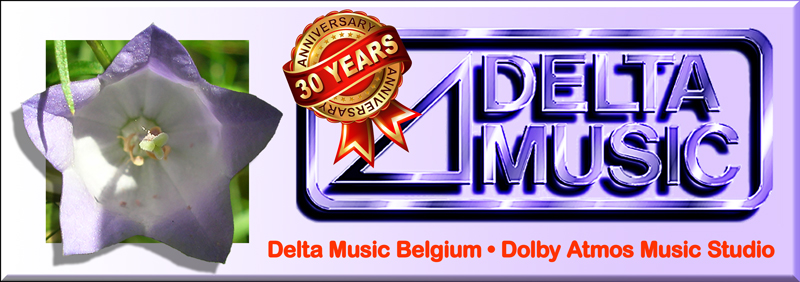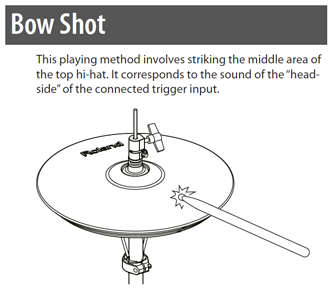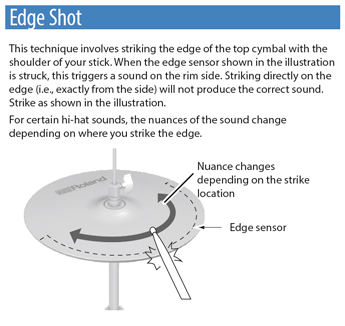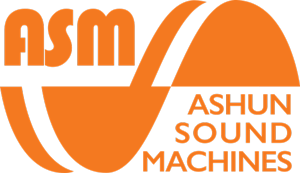News archive 2022
![]()
December 01, 2022 (updated on December 13, 2022)
![]()
New acquisition in my collection hardware synthesizers and MIDI controllers:
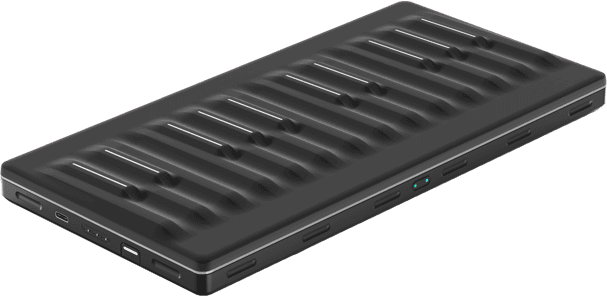
ROLI - Seaboard Block
Anyone who follows me a bit knows that I am a big fan of the ROLI Seaboard RISE 49 that I bought in 2017. This MIDI controller does not have a standard (piano) synthesizer keyboard, but it does have so-called KeyWAVES that are made of soft silicone:

As a result, the entire playing surface is sensitive to positioning and pressure, resulting in 'Five Dimensions of Touch', which are divided into:
- Strike: keywave keystrokes and this corresponds to MIDI CC 'velocity' (like playing soft or hard on a piano key)
- Glide: horizontally moving your finger on a keywave for vibrato and glissando and corresponds to MIDI CC 'pitch bend'
- Silde: moving your finger vertically on a keywave for eg opening a filter or switching to another sound (eg a piano sound that gradually changes into a trumpet) and corresponds to MIDI 'polyphonic aftertouch'
- Press: pressing the playing surface for, for example, the swelling of a sound corresponds to MIDI 'channel pressure' (or 'monophonic aftertouch')
- Lift: the speed of releasing a keywave (eg quick release cuts off the sounding note, slow release causes the sounding note to fade out) and corresponds to MIDI CC 'release velocity'

In 2017 I devoted several extensive posts to the ROLI Seaboard RISE 49, so you can still find more info at:
A few days ago, after a tip from a Dutch friend who had just bought one on my advice, I was able to buy a second-hand ROLI Seabord Block at a reasonable price. This is the smallest of the ROLI Seaboards, has not been made for several years and has therefore become rather rare. This of course has the disadvantage that you can easily pay the original new price for it today (or sometimes people even ask twice the new price).
The ROLI Seaboard Block belongs to the ROLI Blocks, this is a modular system with several types of MIDI controllers, the ROLI Seaboard Block is the Seaboard module:
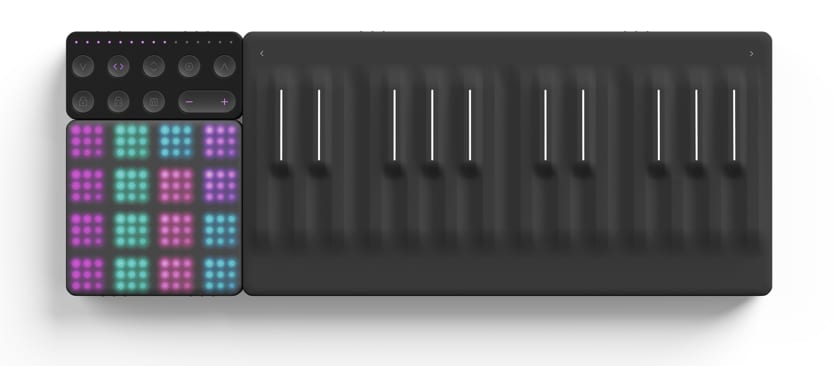
You can magnetically connect these ROLI Blocks modules together to form a large MIDI controller with a maximum of 5 modules. For example, you can also connect two ROLI Seabord Blocks to form a more or less continuous keyboard with 49 KeyWAVES, whereby the KeyWAVES themselves follow each other neatly and correctly positioned. But course the playing surface is interrupted in the middle, which can be difficult if you want to do a 'Glide' in the middle, because if you slide to the 2nd Seaboard Block and touch it, a new note is played and the previous note stops sounding because your finger loses contact with the first Seaboard Block...
The ROLI Blocks system is mainly made to be very portable, which also means that the KeyWAVES on the ROLI Seabord Block are 20% smaller than on a ROLI Seaboard RISE 25 and 49. This is a comparison between a Seaboard RISE 25 and a Seaboard Block:

I mainly bought the ROLI Seabord Block to easily have the 'Five Dimensions of Touch' available outside the studio with a laptop in a handy and portable format. My ROLI Seaboard RISE 49 can then always remain in place in the studio with of course much less risk of damage to its aluminum housing (the housing of a ROLI Seaboard Block is made of durable plastic).
Btw, I have rather small hands, so the ROLI Seaboard Block is a bit easier for me to play than my ROLI Seaboard RISE 49, but at the same time I notice that the ROLI Seaboard RISE 49 is a bit more accurate to play because the KeyWAVES is 20% be larger than on a ROLI Seabord Block. Which is only logical :-)
Addition on December 13, 2022:
By coincidence I was able to purchase a second ROLI Seabord Block in the past few days and to my great surprise this is a rare 'Limited Edition' version! This version is completely black without the standard white stripe all around as seen on all other images in this post. This is an image of a ROLI Seabord Block Limited Edition:
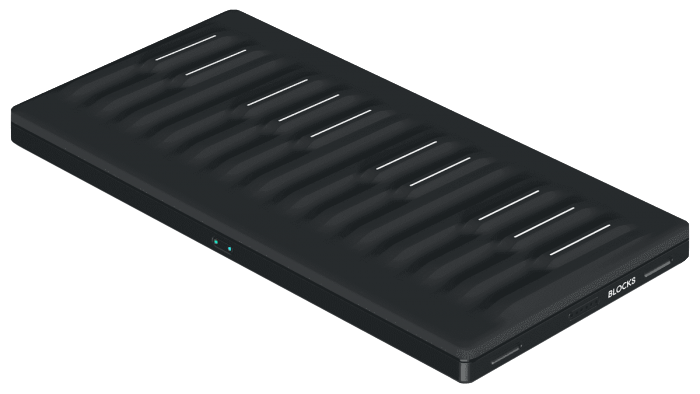
The ROLI Seabord Block Limited Edition was the first batch of ROLI Seabord Block's that became available in November 2016, from batch 2 on in 2017 it then became the standard version with the white stripe all around. From a marketing point of view, this limited edition will probably have ended up mainly with VIPs, reviewers and influencers worldwide, so it is quite special that I just got my hands on one... And at a price that was considerably lower than the first which I bought, the seller was clearly unaware of the fact that he was selling a ROLI Seabord Block Limited Edition and I only discovered it after opening the parcel...
But technically they are identical to each other and it also works perfectly with my standard version. So the difference is only aesthetic + the fact that it was the first batch ever. But I can only be happy about it because I think completely black a Seabord Block looks much nicer...
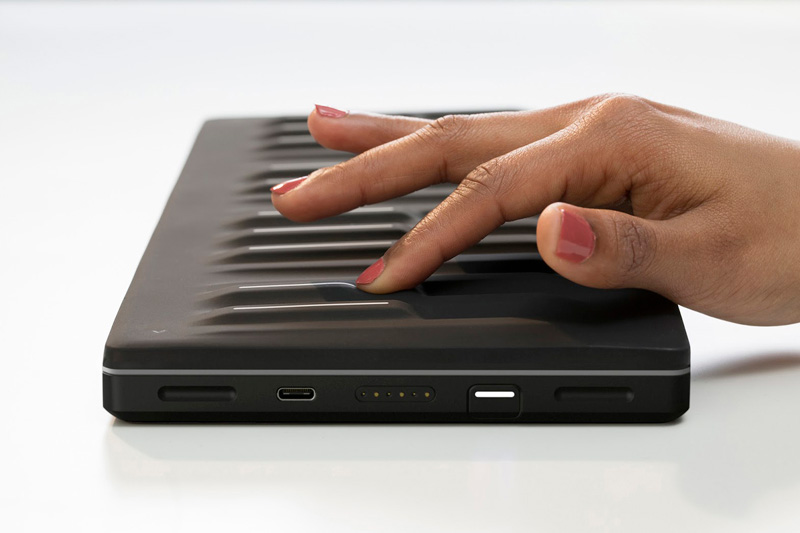
![]()
September 01, 2022
![]()
Delta Music Belgium finally has an SSL!

Oops, wrong message and logo, this is the right one:
www.deltamusic.be finally has SSL!

Of course, SSL or 'Solid State Logic' is the world-renowned mixing console manufacturer from the United Kingdom, just think of the legendary SSL 4000 G+ analog mixing consoles from the 80s such as this one:
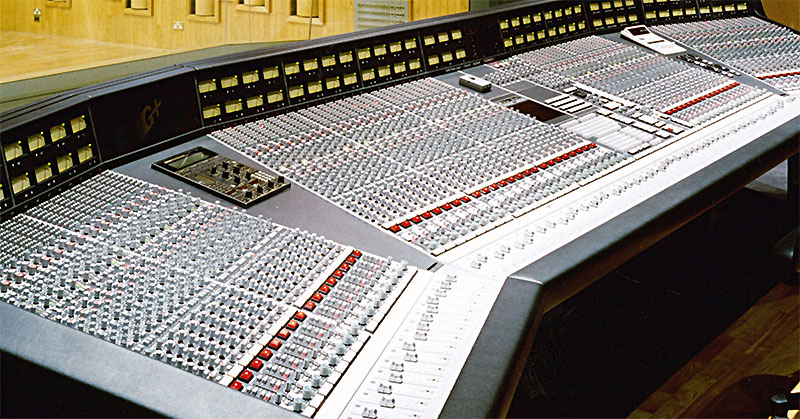
But the chance that I would ever buy a SSL mixing console is almost non-existent since I work with Pro Tools | HDX which is of course the ultimate digital mixing console... In Pro Tools | HDX I have very good plugins from Brainworx (the 'bx_consoles') that emulate different types of old analog SSL mixing consoles, including the SSL 4000 G and also the more recent SSL 4000 E and the SSL 9000 J... And each with built-in “Tolerance Modeling Technology” which makes each SSL mixing console channel in Pro Tools | HDX slightly different from the other channels, just like real analog mixing consoles... And it doesn't stop at SSL because I also have the Brainworx bx_console AMEK 9099 (an AMEK 9098i emulation), the bx_console N (a Neve VXS emulation) and the bx_console Focusrite SC (an emulation of the mixing desk in the legendary AIR Montserrat studio of George Martin of The Beatles).
But enough about those old dinosaur mixing consoles, because of course in this case SSL stands for 'Secure Socket Layer' . This is a method of encrypting the communication between a web server and the visitor, so that the data cannot be eavesdropped on the way. In itself, this is not necessarily necessary for www.deltamusic.be since there are no forms to fill out or emails to be sent anywhere on the website...
But I switched to a new web hosting provider where SSL is included for free + nowadays it is a standard requirement that have a closed padlock in front of your domain name and the server uses https:// instead of https:// so... from now on www.deltamusic.be also has a closed padlock! Yay!

![]()
May 31, 2022
![]()
In memoriam
Dave Smith
April 1, 1950 - May 31, 2022
And another week later, this is the 6th In Memoriam in 2022 for an important figure from the music world...
This time it's not about the death of a famous musician or composer, but about an American engineer in electronics and computer science (although he was also a musician). Dave Smith was one of the founders of synthesizers as we know them today. He was the founder of the company 'Sequential Circuits' in 1974 and was directly responsible for the development of the legendary 'Prophet-5' synthesizer in 1979, the first polyphonic synthesizer with a built-in micro-processor that allowed you to store sounds patches in a memory .

The photo above is of an original Prophet-5, but since 2020 you can buy a new, more modern version of the Prophet-5, the Prophet-5 from 'Sequential'. This company is the contemporary incarnation of the original Sequential Circuits company, which was forced to close its doors in 1987 due to too small and too little capital to compete with other synthesizer manufacturers. Dave Smith was forced to sell his company to Yamaha and lost the rights to use the name 'Sequential Circuits' as a result. In 2002 Dave Smith founded the company 'Dave Smith Instruments' to be able to design and build synthesizers again. However, in 2014 Yamaha gave him back the rights to use the original 'Sequential Circuits' name. In 2015, Dave Smith immediately founded a new company with the name 'Sequential' being a shortened version of the original name 'Sequential Circuits'.
This is a photo of a Sequential Prophet-5 for comparison with the photo above:

Unlike the original, this recent Sequential Prophet-5 does of course have a built-in MIDI interface. As a matter fact, in 1981 Dave Smith, was, together with Ikutaro Kakehashi (founder of Roland), responsible for developing MIDI (Musical Instrument Digital Interface) through which synthesizers, sequencers and drum machines can communicate with each other. It was at the 1983 Winter NAMM Show in Anaheim, California (USA) that for the first time in public 2 synthesizers communicated with each other via MIDI and this was a Sequential Circuits Prophet-600 with Roland Jupiter-6, as seen in the photo below:
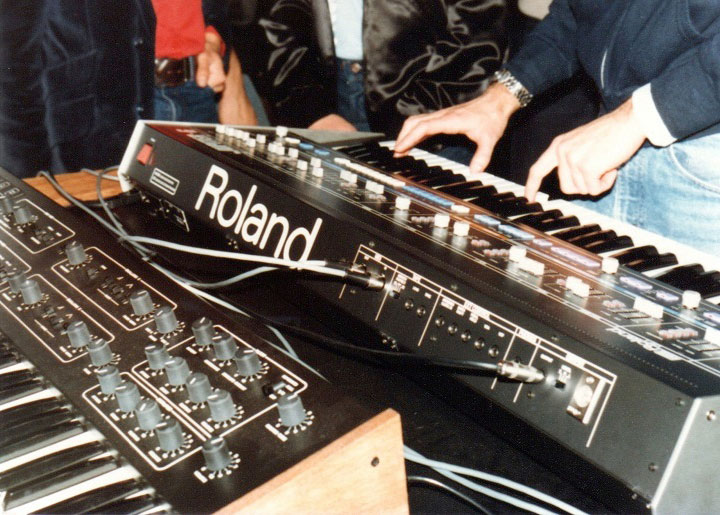
© MIDI Manufacturers Association
FYI, when Dave Smith got the rights to the name 'Sequential Circuits' back from Yamaha in 2014, it was at the urging of Ikutaro Kakehashi and in gratitude by Yamaha for Dave Smith's contribution to the development of MIDI, which has since become a worldwide standard.
In summary, the importance of Dave Smith for the world of synthesizers and electronic music production cannot be underestimated... And consequently also for me personally, because I have been working with synthesizers and MIDI since my first steps in the music world.
I've passed Dave Smith at some music fairs, but I've never spoken to him. Nor have I ever owned a Prophet-5 or any other Dave Smith-designed analog synthesizer for the simple reason that American synthesizers were very expensive in the 1980s. At that time I was mainly dependent on the cheaper Japanese synthesizers from Roland and Korg + I thought (and still think) that these sound nicer and a bit more polished than the first American synthesizers from e.g. Sequential Circuits, Oberheim, Moog, etc...
A few years ago I did buy a Prophet-X from Sequential, but a Prophet-X actually has little or nothing to do with the legendary Prophet-5 synthesizer because the Prophet-X is not an analog synthesizer like the Prophet-5. A Prophet-X is a fully digital synthesizer and sampler, but with very nice-sounding analog filters.
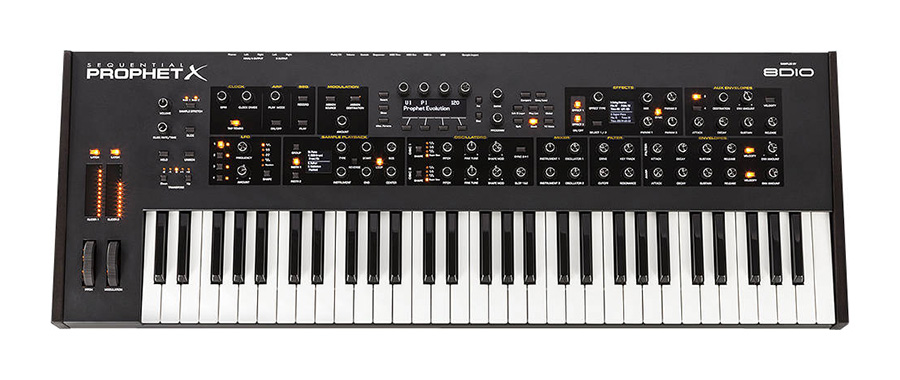
By the way, Dave Smith helped design the Prophet-X, so eventually I still have some of his work in my studio (if you ignore all the built-in MIDI interfaces on virtually all my other synthesizers). My Prophet-X also contains samples of Dave Smith's personal Prophet-5, the very last original Prophet-5 that was made, a Prophet-5 rev 1.3 (unit number 6427) from 1984 (not that this is so special, because this collection is simply for sale online at sample library producer 8DIO).
And to conclude and as a tribute, a stylized representation of a 5-pin DIN MIDI connector...
Kudos to Dave Smith because without him my life would probably have looked completely different...
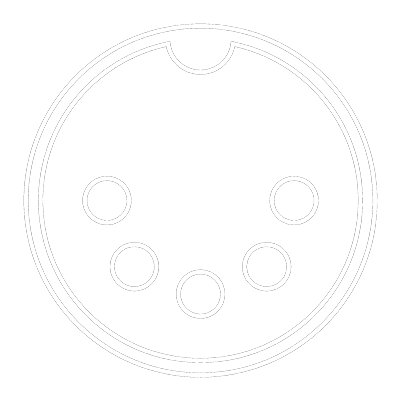
![]()
May 26, 2022
![]()
In memoriam
Andrew Fletcher
Juli 28, 1961 - May 19, 2022
And exactly a week later I have to report a 5th death in 2022...
As a lover and collector of synthesizers, the British synthpop formation Depeche Mode has been very important to me from day one and it is therefore with great sadness that I have to announce the death of group member Andrew Fletcher. He was 1 of the 2 remaining founding members of Depeche Mode. Andrew Fletcher founded the band 'No Romance In China' with Vince Clarke in 1976 and after some name changes in 1980, together with additional members Martin Gore and Dave Gahan, he formed the band Depeche Mode (however, in 1981 Vince Clarke left the band and Alan Wilder joined the band in 1982 and remained a member until 1995).
Andrew Fletcher was the leading figure behind Depeche Mode, the glue that held everything together to this day. In the studio he was the driving force and motivator, but live on stage he stayed in the background with vocalist/guitarist Martin Gore and especially vocalist Dave Gahan clearly in the foreground.
Actually I've only seen Depeche Mode live 3 times, the first time was in 1985 with the 2 legendary concerts at the Torhout/Werchter rock festival (I was present on the 2nd day in Werchter). There they were reviled by the rock-loving public for daring to work with backing tapes and that was absolutely not accepted at the time. These 2 concerts, with all the negative reactions from the public and especially how they were mercilessly slammed down in the Belgian music press, made a very deep impression on the members of Depeche Mode...
The second time I saw Depeche Mode live was only 24 years later in 2009 at TW Classics and then a third time in 2013 at the Rock Werchter Festival. So basically I saw them 3 times in the same place, but the name of the festival was different every time.
Whether the death of Andrew Fletcher will also mean the end of Depeche Mode remains to be seen, but maybe Martin Gore and Dave Gahan will bring ex-member Alan Wilder back on board, who knows...

![]()
May 19, 2022
![]()
In memoriam
Vangelis
(Evanghelos Odysseas Papathanassiou)
March 29, 1943 - May 17, 2022
Today I have to report a 4th death in 2022...
And the death of my greatest idol...
The man I consider to be the greatest composer ever...
And my biggest source of inspiration...
Today it was officially announced that Evanghelos Odysseas Papathanassiou passed away the day before yesterday on May 17, 2022 in Paris...
Many people know Vangelis mainly for the many film scores he has written, of course especially for 'Chariots of Fire' (1981) for which he received an Oscar, or for the music he wrote for 'Blade Runner' (1983) and had even an outright hit with 'Conquest of Paradise' (1995). But he also wrote music for films like 'Missing', 'Bitter Moon', 'El Greco', etc...
But for me the connection with Vangelis goes back much further than his well-known film music, because the first vinyl LP I ever bought was from Vangelis. It was the LP 'Albedo 0.39' from 1976 and today I own just about all his work, but of course not on LP but on CD. In fact, the above is not entirely correct because the first LP I ever bought was actually by the British hard rock band Whitesnake, because I bought it because a classmate in high school had also bought it when we were in a record store together (I suppose it was pure conformational behaviour). So the LP 'Albedo 0.39' was physically the second LP I ever bought, but it was the first LP I bought because I really wanted it so much myself.
I had heard that music in the late 70s at another classmate's house, his older brother had this LP in his collection. After listening to this LP in that classmate's living room, I was almost immediately enchanted by it and immediately lost my heart to it. I thought that 'cosmic music' was so magical and so different from anything I'd ever heard before, it was a life-defining event for me at the time (although I didn't realize it at the time of course). Soon I also bought his LPs 'Heaven and Hell', 'Spiral', 'Beauborg' and 'China', also all work from the 70s, music that I mainly discovered in the early 80s...
FYI: the link between the music of Vangelis and 'cosmic music' arose in the late 1970s by the well-known writer and astronomer Carl Sagan who used Vangelis music as intro music (a piece from 'Heaven And Hell Part I') as well for the many images of planets and the universe that appeared in the series.
In that period the seeds were sown to want to make electronic music myself and I bought my first synthesizer in the mid-eighties, it was a KORG MS-20. This was the start of my collection of synthesizers that now consists of more than 30 pieces (with a solid sound recording studio around it).
This is a well-known quote from Vangelis from an interview about the use of synthesizers:
"I'm not saying acoustic instruments are not valid. I think they're perfect, and they're always going to be there. But if you want to go beyond that, like using a microscope, or a telescope, then you use a synthesizer. I think that's maybe the best example I can give."
I can therefore say with good reason that without Vangelis I might never have started with synthesizers and Delta Music Belgium might never have existed...
I have also personally met Vangelis a few times and in 1999 I also saw him perform live in the port of Rotterdam. It was the Vangelis Eureka concert where I mainly remember the bad weather, but it was still a very impressive experience. This concert can still be found on YouTube because it was also broadcast on TV at the time.
Well... it is with a lot of pain in my heart that I have to report this sad news today, I'm really not feeling well...
I think I'm going to listen to some music tonight...
And maybe quietly wipe away a tear...
Especially when I hear 'La petite fille de la mer' that he wrote in 1973 for the documentary 'L'Apocalypse des animaux'...
Because to me this is the most beautiful thing Vangelis has ever written...
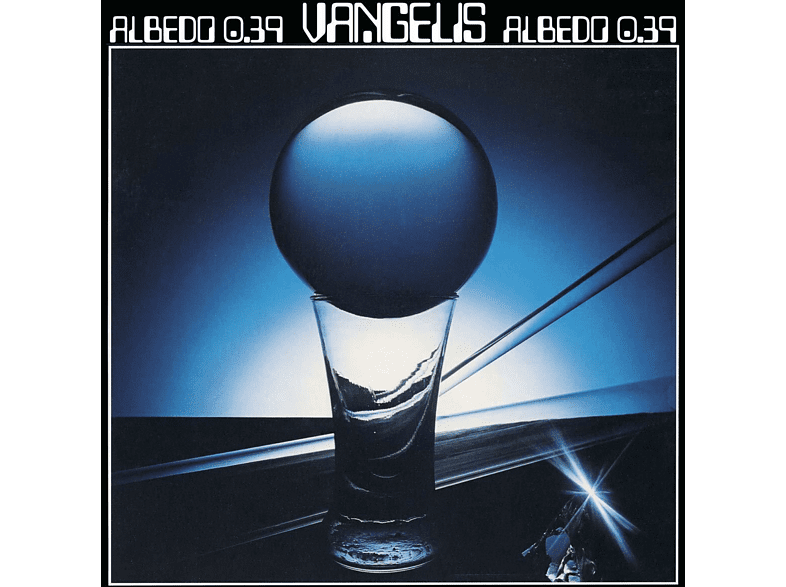
![]()
May 03, 2022
![]()
Finally arrived:
Roland VH-14D Digital Hi-Hat
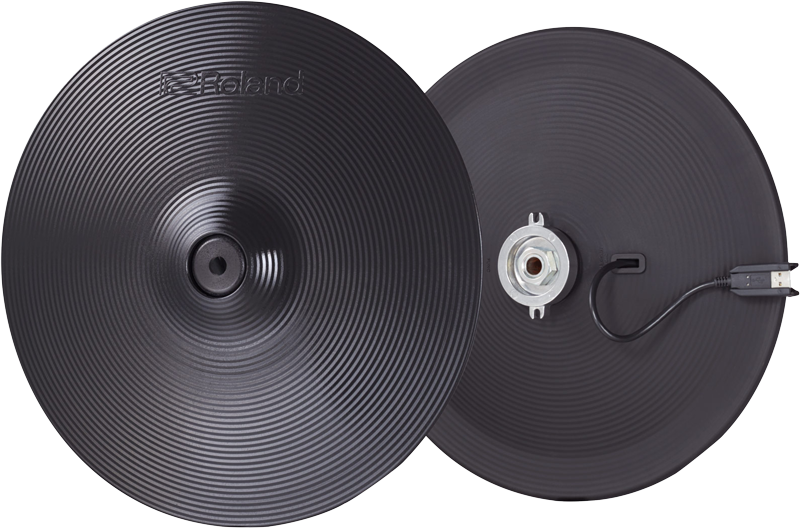
In my post from September 21, 2021 I wrote that I had ordered the Roland VH-14D digital hi-hat at the time, but that nobody could predict when it would actually be delivered. But now it's finally here, it's arrived and I've already installed it!
In my current Roland TD-50KV V-Drums electronic drum kit, the VH-14D digital hi-hat replaces the original VH-13 MG (metallic gray) hi-hat. The VH-13 has been on the market for over 10 years, so a technological upgrade may have been desirable.
The first difference between the two is that the VH-14D is larger than the VH-13, the diameter measures 14-1/16" versus 12-3/8" (so the VH-13 was really just a VH-12-3 /8). In the metric system this is 356 mm compared to 314 mm and therefore a difference of 42 mm, which is quite significant.
The second difference is that the VH-13 connects analogously to the TD-50X drum module and the VH-14D digitally via USB, just like the PD-140DS digital snare drum and the CY-18DR digital ride cymbal.
And the third and most important difference is that the VH-13 only has 3 sensors (Bow, Edge and Motion) while the VH-14D has 3 Bow sensors, 1 Edge sensor, 1 Motion sensor and also a Touch sensor. This obviously has major consequences for the playability of both hi-hats.
Both have a Motion sensor that detects an Open or Closed hi-hat + the amount of pressure applied to the hi-hat pedal when the hi-hat is Closed (the harder you press with your foot the higher the pitch becomes, just like on an acoustic hi-hat). So here the difference in playability is rather small, although it is not known whether or not the Motion sensor in the VH-14D is the same as in the VH-13 (it is rumored that the Motion sensor in the VH-14D would work optically and would therefore be much more accurate, but this is not confirmed by Roland)
But there are big differences in the playability of the cymbal, the following information comes from both manuals:
Roland VH-13 hi-hat:
Roland VH-14D digital hi-hat:
The drawings speak for themselves I think, the VH-14D digital hi-hat can be played much more accurately because it now also detects the position of the tip of the drumstick on the cymbal (and the TD-50X drum module also knows this information to to changes in the timbre and pitch of the hi-hat sound).
I have already extensively tested the VH-14D digital hi-hat and the difference in playability is quite large. If you just play some tight rock or pop patterns, the VH-13 will get you far, but once you start playing more jazzy or more elaborate hi-hat patterns, the differences become very clear, the VH-14D feels and sounds much more realistic than the VH-13.
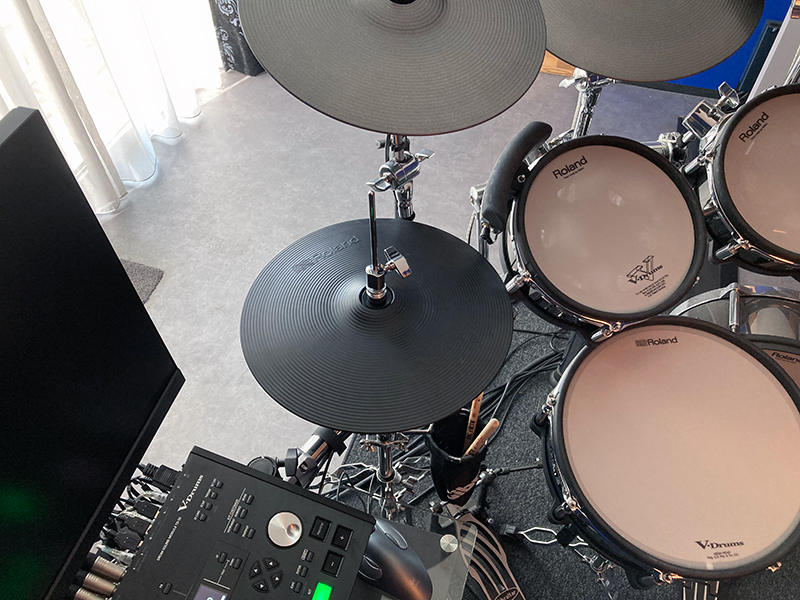
![]()
April 26, 2022
![]()
In memoriam
Klaus Schulze
August 04, 1947 - April 26, 2022
Yesterday I was talking about the year 2016 with its many deaths of well-known artists, today I have to report a 3rd death, well...
The name Klaus Schulze may not sound very familiar to the general public, but for synthesizer lovers he is one of the big names in the world of electronic music. He was, along with Tangerine Dream, one of the founders of the so-called 'Berlin School' in the 1970s. This music movement is characterized by the use of large modular Moog synthesizers and sequencers and when composing and making music it was very typical to use many repetitive sequences and improvise on them.
He has recorded over 40 albums and to be honest it wasn't really my thing because I generally find his music rather dull and floaty (and that goes for just about the entire Berlin School). But about 10 years ago he came back in my sights because he started working with the singer Lisa Gerrard of the legendary band Dead Can Dance (of which I am a big fan). I discovered this by accident through a concert film on Youtube and I was very impressed at the time...
In any case, his influence on electronic music over the years cannot be underestimated, it is also true that he just finished a new album with the title 'Deus Arrakis' that will be released posthumously.
![]()
April 25, 2022
![]()
In memoriam
Henny Vrienten
July 27, 1948 - April 25, 2022
The day before yesterday Arno, today Henny Vrienten, it is starting to look like 2016... (with the deaths of David Bowie, George Martin, Prince, Toots Thielemans, Leonard Cohen and George Michael)... Henny Vrienten is of course especially known as singer/bassist of the Dutch pop group Doe Maar, who also achieved high peaks in Flanders in the early 1980s. For me, therefore, a lot of youth sentiment, because those were just my early teens.
Many years later I met him several times in Dutch sound recording studios, during that period he was mainly busy writing film music. I especially remember how concentrated and driven he was then, but maybe this was just the difference in mentality between ambitious Dutch people and their more modest southern neighbors...
![]()
April 23, 2022
![]()
In memoriam
Arno Hintjens
May 21, 1949 - April 23, 2022
It was in line with expectations due to his protracted illness. but it still came suddenly and unexpectedly, Arno had to give up the fight after all... His music has been a constant in my life, I have also seen him perform live many times at all kinds of festivals. It was always impressive and sometimes it hit you straight into your soul...
I briefly met him a few times and then he was rather closed and shy, until he got behind the microphone and apparently effortlessly lived up to his legendary status, very impressive!
PS: I deliberately no longer place photos of famous Belgians on my site, even though I am a strong supporter of copyrights, because press agencies with strict algorithms actively hunt for the illegal use of photos... personally experienced and I don't bump into the same stone twice...
![]()
Februari 01, 2022
![]()
New in my synthesizer collection:
(but not really)
ASM - HYDRASYNTH Deluxe

In my post from November 15, 2020 you can read about my purchase of the ASM HYDRASYNTH, my first synthesizer with POLYPHONIC AFTERTOUCH!
However, now I have bought a HYDRASYNTH Deluxe, the big brother of the HYDRASYNTH. These are 2 photos for comparison:

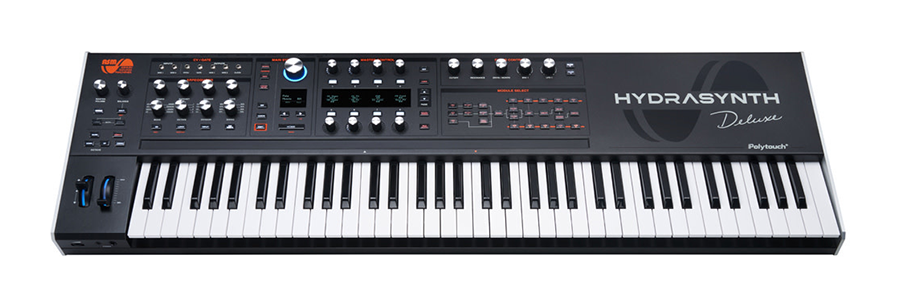
I think the pictures and also the name HYDRASYNTH Deluxe need little explanation: the HYDRASYNTH Deluxe is... the deluxe version of the HYDRASYNTH :-)
What are the differences:
- the HYDRASYNTH has a 49-key keyboard (4 octaves) with polyphonic aftertouch and 1 engine with 8 voices
- the HYDRASYNTH Deluxe has a 73 key (6 octaves) keyboard with polyphonic aftertouch and 2 engines with 2 x 8 voices or combined 1 x 16 voices
To summarize even more, the HYDRASYNTH Deluxe is 2 x a HYDRASYNTH with a larger keyboard.
Those 2 HYDRASYNTHs can sound together (layered) or used in split mode, each with 8 voices, each with their own sound. Or it becomes 1 double siwzd HYDRASYNTH with 16 voices and 1 sound spread over the entire keyboard.
The touch ribbon is 4 octaves long on both versions, as can be seen on the photos. You also immediately see the front panels are actually identical, with the exception of the left side. With the HYDRASYNTH there is 1 volume button, with the HYDRASYNTH Deluxe there is 1 volume button and 1 button for the balance between the 2 engines + below that some push buttons for layering and split modes.
I was already very satisfied with the ASM HYDRASYNTH, in any case because of its keyboard with polyphonic aftertouch, but also because of its very extensive sound options. It actually made sense to buy the HYDRASYNTH Deluxe, because now I have 6 octaves of polyphonic aftertouch and 2 HYDRASYNTH engines in the same machine. It therefore makes little sense to keep that original HYDRASYNTH in my synthesizer collection and it will be sold.

![]()
January 03, 2022
![]()
New in my synthesizer collection:
Arturia - PolyBrute
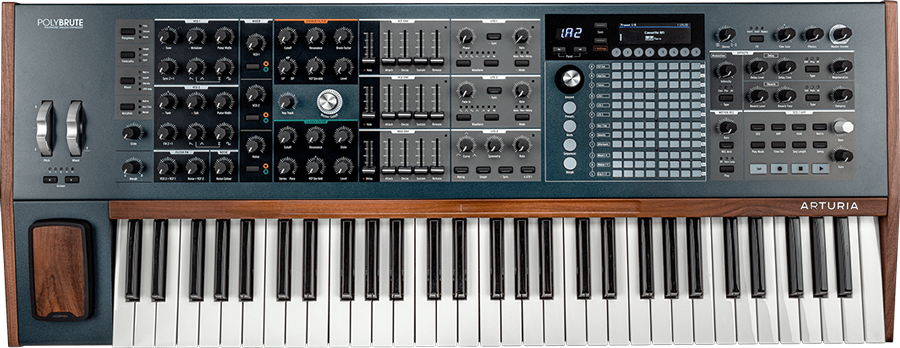
First of all, I wish everyone a happy and healthy 2022!
I've already received a wonderful New Year's gift: an ARTURIA PolyBrute synthesizer described as a Morphing Analog Polysynth!
In my post from May 29, 2018 you can read about the purchase of my first ARTURIA synthesizer, the majestic ARTURIA MatrixBrute!
Although, this is not entirely correct because I once had an ARTURIA synthesizer before that, namely an ARTURIA MiniBrute SE (Sequencer Edition):
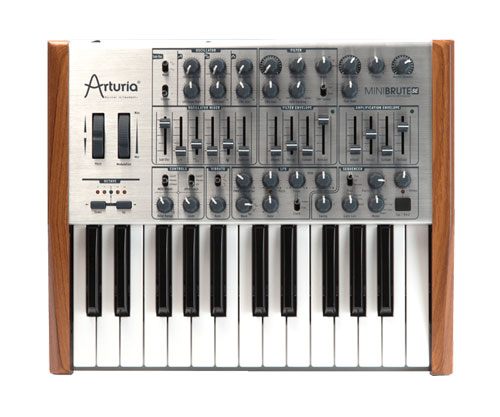
But the MiniBrute SE I had did have gray wooden side panels. I didn't like the original natural wood side panels as seen above and asked ARTURIA if they could send me standard gray side panels of the regular ARTURIA MiniBrute (which ARTURIA did for free, what a service!). But after a while I found the possibilities of this little synthesizer a bit too limited, also the fact that it has no patch memory bothered me very much, with the result that I eventually sold it.
But in terms of sound, I thought the ARTURIA MiniBrute was very special at the time and this contributed to the purchase of an ARTURIA MatrixBrute in 2018. This is a very extensive monophonic analog synthesizer where the 16 x 16 button matrix stands out:
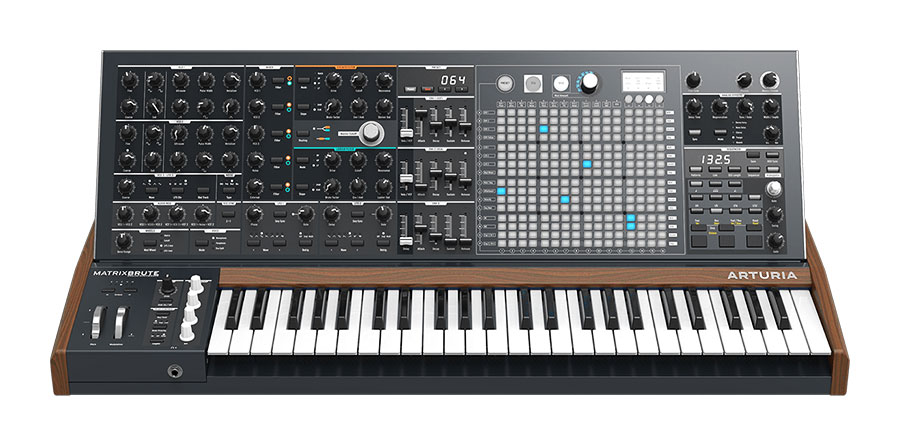
That matrix is also present on the ARTURIA Polybrute, but in a smaller 10 x 16 version. And furthermore, it is also very clear in terms of design the MatrixBrute and the PolyBrute are are related to each other, with identical buttons and a very similar layout:
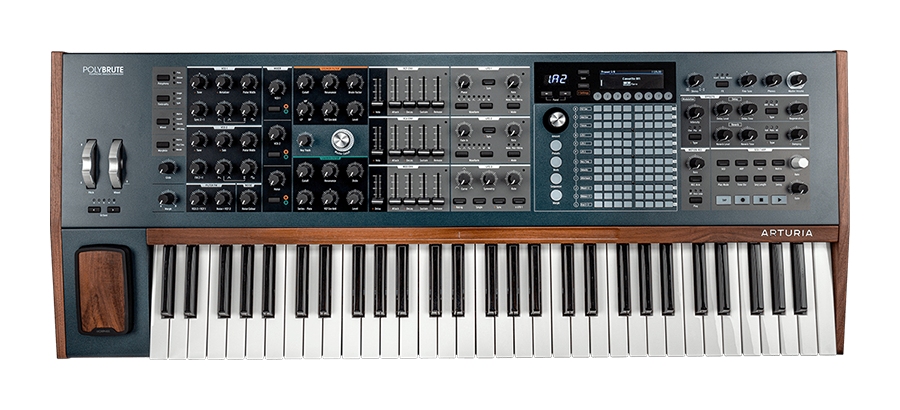
And as the name PolyBrute already indicates, this is not a monophonic synthesizer like the MatrixBrute, but a polyphonic synthesizer with 6 voices. In short, you could say that the PolyBrute is a polyphonic version of the MatrixBrute, but that would do the PolyBrute far too little credit.
Because the PolyBrute has 1 very important function for an analog polyphonic synthesizer: it can morph between 2 presets! So instead of switching between 2 presets A and B, the PolyBrute can morph between A and B with each parameter changing proportionally. There are some digital synthesizers and plugins that can morph, but the ARTURIA PolyBrute is currently the first and only polyphonic, analog synthesizer that can do this. This can be done with the morph dial (the bottom button on the left) and with the 'MORPHEE', the three-dimensional X/Y/Z morph pad (the brown pad to the left of the keyboard):
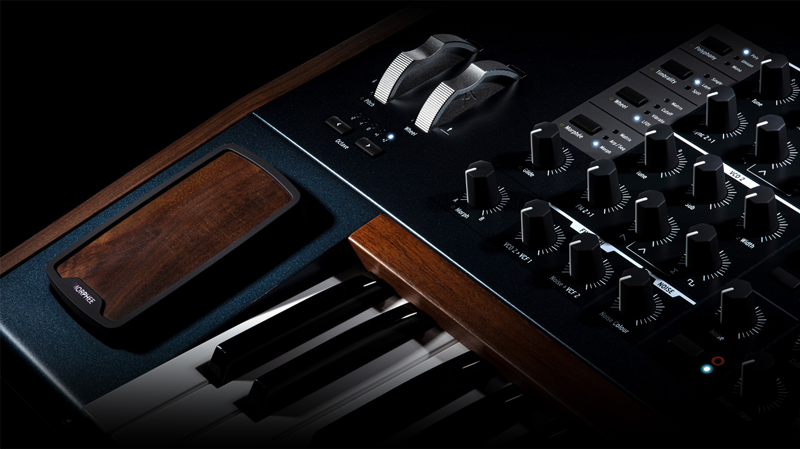
Above the 61-key keyboard (with duophonic aftertouch) there is also a ribbon controller embedded in the wood for YAMAHA CS-80-style glide and modulation effects:
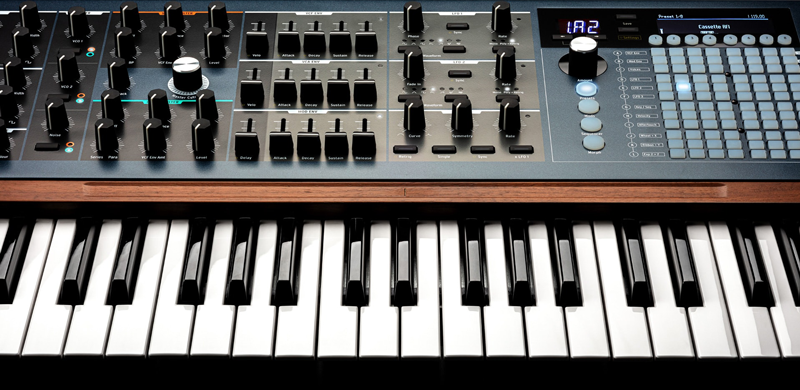
The ARTURIA PolyBrute also has:
- 2 x analog VCOs with 6 functions (including the Metalizer that ARTURIA is so famous for)
- 12dB/Oct Steiner Parker filter
- 24db/Oct Ladder filter with distortion
- 3 x ENV
- 3 x LFO
- 4 x stereo digital effect processor
- 64 step polyphonic sequencer
- arpeggiator and matrix arpeggiator
- 768 preset slots
There are of course many more technical specifications, but it would lead too far to list and discuss them all here.
I've had the ARTURIA PolyBrute in the studio for a few weeks now and I'm very impressed with this beautiful synthesizer! Although I have to add that I think it looks rather ugly, just like the MatrixBrute, because I'm not a fan of a lot of wood on a synthesizer. Especially the MORPHEE, the three-dimensional X/Y/Z morph pad, I find very ugly, it's like a wooden smartphone from prehistoric times :-)
The sound palette ranges from very warm and very sweet to extremely hard and aggressive. The word 'Brute' in his name is there for a reason, just like in all other incarnations of the ARTURIA Brute Series. The 6-voice polyphony is of course quite a relief compared to the monophonic MatrixBrute, 8 voices might have been even better, but this would undoubtedly have driven up the sales price considerably.
But the morphing really beats everything, this is done so well and intelligently! Any preset can morph into any other preset and in between in many cases you get completely different sounds that you can then save as a new preset (and so the game starts all over again). The ARTURIA PolyBrute is a dream for experimental sound designers, but even morphing between 2 presets that actually differ little from each other can be very beautiful and surprising. The built-in ribbon controller is also very nice, Vangelis is never far away and I always think that is a very good thing :-)

![]()

![]()
![]()
Copyright © 1995-2025 by Delta Music Belgium • Dolby Atmos Music Studio • Rummenweg 30 • 3800 Sint-Truiden • Belgium
All Rights Reserved
Privacy notification and cookie policy
All product names, logos, and brands are property of their respective owners.
All company, product and service names used on this website are for identification purposes only.
Use of these names, logos, and brands does not imply endorsement.
![]()
